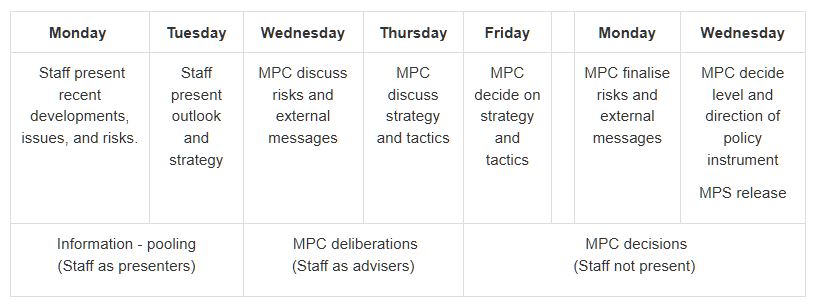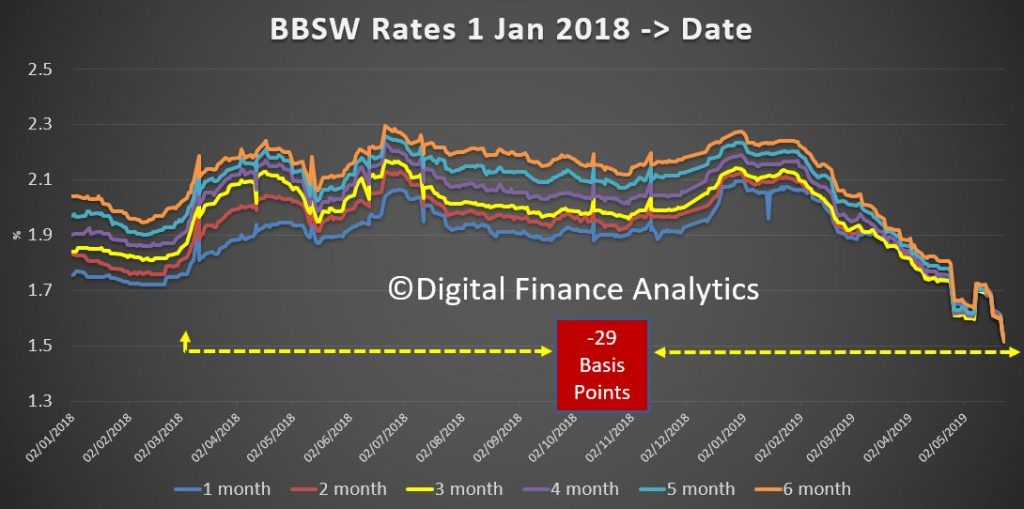I discuss the latest attempt to deal with deposit bail-in with Robbie Barwick from the CEC, who have just launched a new petition seeking to exclude bank deposits.
Category: Banking Culture
Visionary RBNZ Shows Up RBA
The Reserve Bank of New Zealand has released an important statement on the new approach they are going to adopt in policy setting. The focus will be on improving wellbeing. In addition they are expanding their dna to avoid group think. This follows their recent moves to lift bank capital.

There is so much here the RBA should embrace.
The Reserve Bank has significantly changed the way it makes monetary policy decisions, keeping itself in step with public expectations.
In a panel discussion last week at the Institute for Monetary and Economic Studies (Bank of Japan) in Tokyo, Reserve Bank Assistant Governor and General Manager of Economics, Financial Markets and Banking Christian Hawkesby talked about the importance of good decision making and governance, and of being credible and trusted, in achieving the long-term goal of improving wellbeing.
“We maintain our legitimacy as an institution by serving the public interest and fulfilling our social obligations. Keeping our ‘social licence’ to operate depends on maintaining the public’s trust that we are improving wellbeing,” Mr Hawkesby said.
“Thirty years ago New Zealand was prepared to accept a single expert – the Governor – making decisions about how to fight inflation. People now expect to see how and why decisions are made, expect that decision makers reflect wider society, and that current issues and concerns are factored into the decision making. By meeting these expectations, we can improve public trust in the legitimacy of the Reserve Bank’s work,” he said.
Mr Hawkesby outlined the new committee process that the Reserve Bank uses for deciding the official cash rate, noting that diversity among decision makers improves the pool of knowledge, insures against extreme views, and reduces groupthink.
“This diversity is needed to confront issues such as climate, technological, and other structural and social changes,” he said.
He also said that collaboration with government can be undertaken in a way that maintains the Reserve Bank’s political independence while working on the broader objective of improving wellbeing.
Here is the supporting speech.
Introduction
Tena koutou katoa
Thank you for the opportunity to talk about the Reserve Bank of New Zealand and the changes we are making to maintain our credibility in times of change.
I would like to focus on two building blocks of credibility:
- renewing a social licence to operate by aligning our objectives with the needs of the public; and
- achieving those objectives through good decision making enabled by a framework of good governance.
A common theme is the importance of transparency.
The imperative for change: Central banks in the 21st century
The first building block of credibility is the renewal of a social licence to operate—by this I mean the legitimacy an institution earns by serving the public interest. It is granted by the public when an institution is seen to fulfil its social obligations.1
New Zealand was the first country to officially adopt inflation targeting in 1989, with a number of central banks around the world following the example.2 Under a single-decision-maker model, we brought inflation down from around twenty percent to two percent in five years. In doing so, we helped build our credibility during the high-inflation environment of the times.3
Fast-forward to 2019, and monetary policy in New Zealand has undergone major change. Firstly, we have adopted a dual mandate, focused on achieving price stability and supporting maximum sustainable employment. Secondly, we have adopted a committee structure for decision making, and are delivering greater transparency in our decision making.
Why the change?
The reform of our framework was not merely a simple choice based on technical performance. As you can see in figure 1, when it comes to inflation and growth, over the past 30 years inflation-targeting central banks (e.g. New Zealand and the United Kingdom) have a pretty similar track record to central banks with a dual mandate (e.g. Australia and the United States). 4
The imperative for change comes from more than examining our history; it comes from our expectations of the future, and the present we find ourselves in. Our policy framework changed because times are changing. For the Reserve Bank to maintain its credibility and relevance, we must change too.
Figure 1: Inflation, and GDP growth across monetary policy frameworks5

Wellbeing of our people
Inflation has been low and stable in New Zealand for nearly 30 years.
There is a greater appreciation that low inflation is a means to an end, and not the end itself. In the fight to lower inflation that was perhaps easy to forget. The end goal is, of course, improving the wellbeing of our people.6
For many in the general public, employment is one tangible measure of wellbeing. Employment can provide an opportunity to earn your own wage, contribute to society, and live a fulfilling life.
It is in this light that the Reserve Bank Act (1989) has been amended to include a dual mandate with an employment objective alongside our price stability goal. Incorporating the objective of supporting maximum sustainable employment, and equally weighting it alongside inflation, emphasises our long-term goal of improving New Zealanders’ wellbeing. This aligns us with the needs of the public. And it helps us renew our social licence to operate – the first building block for maintaining our credibility.
But it is not enough for the public to believe in and understand our objectives. We must also prove to them that they can be achieved. This brings us to the second building block necessary for maintaining credibility: establishing modern governance principles for dealing with modern problems, and translating good governance into good decisions.
Good governance
In preparing for our dual mandate, and a formal Monetary Policy Committee (MPC), we have updated the principles and processes that form our governance framework for monetary policy.
In pursuit of greater transparency, we have also published these principles and processes in a comprehensive Monetary Policy Handbook (the Handbook). 7 This is an essential document, for everyone from school students to MPC members.
Importantly, it is also a living document that will evolve as our understanding evolves.
Principles
The first part of the Handbook I would like to cover is the section on MPC deliberation principles. 8
Figure 2: MPC deliberation principles
There are three principles which guide the deliberations within the MPC.

I’ve talked already about providing clarity around our objectives – the equal weighting of our employment and inflation goals. This is the first of our three principles.
The second, is diversity – diversity in the skills, experiences, thoughts, and personal characteristics of the MPC members.
The third, is inclusion – inclusion of information and people, ensuring decisions are made on the basis of all the available insights, and reflecting the views of all of the committee members.
Why are diversity and inclusion so important?
The governance literature shows that diversity and inclusion improves the pool of committee knowledge, insures against extreme views, and reduces groupthink.9 These principles drive the committee towards an unbiased policy decision – the best that is possible given existing information.
Think about this from a practical perspective. Modern monetary policy is confronted by diverse issues such as climate, technological, and other structural and social changes. A sole decision maker or uniform committee cannot possibly hope to possess the broad range of insights necessary to consider these issues.
A diverse committee operating in an inclusive environment can. It is these additional insights that improve collective understanding, and lead to better monetary policy decisions.
So you see these principles are not simply rhetorical devices. They are carefully chosen pillars to support our credibility though good decision making in achieving our dual mandate.
Good decision making
Processes
Our principles of good governance have directly influenced the policy-setting process of the MPC. 10 This is a process that has been designed with consensus-based decision making front and centre, consistent with the agreement with the Minister of Finance. 11
Figure 3: The structure of the forecast week for quarterly Monetary Policy Statements

We begin with information pooling, which flows through to MPC deliberations, and culminates in the final decision making meeting.
As you can see, the policy-setting framework is highly collaborative and deliberate. Deliberate in the sense that the process inspires lively debate, giving MPC members every possible chance to challenge assumptions, critique policy judgements and assess a range of policy strategies to achieve our dual mandate objectives.
A crucial part of this is that the MPC members hold back their views on the decision until the final stages, rather than starting with them. This supports evidence-based decision making and guards against confirmation bias.
The process begins with open information pooling on recent developments and the outlook for the economy. Here, the MPC have the opportunity to investigate and challenge the assumptions made in the staff’s initial forecasts. This is where the MPC member’s judgement enters the picture, and where creative tensions improve collective understanding.
While the MPC members may enter the room with different insights and questions about the economy, at the end of the information pooling stage the committee shares a common reference point for the economic outlook.
There are numerous opportunities to discuss and reflect on key issues, judgements, risks, strategy, and communication throughout the week. There are also a number of anonymous internal surveys we perform to gauge collective opinion among staff and MPC members.12
By the end of the week-and-a-half, the final monetary policy decision reflects the greater momentum of the MPC’s discussion.
We publish the final Official Cash Rate (OCR) decision, a Monetary Policy Statement (MPS), and a Summary Record of Meeting at the same time.
The Summary Record of Meeting captures the key judgements and risks underpinning the central forecasts and decision, as well as indicating where members of the MPC had different views. We identify any differing views, and communicate where the most significant uncertainties lie in our baseline forecasts.13 If consensus cannot be reached, a vote by simple majority would be carried out, and the reasoning behind different stances disclosed in the Summary Record of Meeting.
Our desire is that the transparency provided in the Handbook can help the public understand how the Bank’s collective ‘mind’ works. If the public can see the analytical rigour in our decision making, they should have greater confidence in the MPC’s conclusions, and thus more faith in the Reserve Bank.
Our credibility will be supported in the long run if the decisions made by the MPC are unbiased and effective ones. Our results will speak louder than our words.
Monetary policy strategy and our May decision
So far I’ve talked about the principles and processes we follow in setting policy. Now I’m going to cover how we ‘walk the talk’ in formulating our monetary policy decisions.14
Sound and effective monetary policy strategy requires more than just deciding whether the OCR should go up or down on any given day; instead central banks need to be transparent about their views of the economy over the medium-term and how monetary policy might respond to a changing economic landscape.
In this regard, around twenty years ago, the Reserve Bank became a pioneer in another way. When publishing our interest rate decisions, we also began to publish a forward (and endogenous) projection of interest rates in the future. We use this to capture the overall stance of monetary policy.
This tool remains integral to how the MPC sets monetary policy and understands the potential trade-offs with a dual mandate.
The first monetary policy decision of the new MPC occurred last month, in May. Our starting point was a New Zealand economy where the labour market was operating near maximum sustainable employment, and annual core inflation pressures were within our 1 to 3 percent target range but below the 2 percent mid-point.
We discussed the slowdown in global growth, and how this might affect New Zealand. We also addressed the recent loss of domestic economy momentum since mid-2018, through both tempered household spending and restrained business investment.
In order to continue achieving our policy objectives, we agreed that additional monetary stimulus was needed to help bring inflation back to the 2 percent mid-point and support maximum sustainable employment. We then turned to the question of the magnitude of stimulus we wanted to adopt (the stance) and the timing and means by which we would try to deliver this (the tactics).
Figures 4–6 show how different OCR paths could have been used to achieve our objectives. While each path was consistent with meeting our objectives, they each offered different trade-offs.15
Figure 4: Official Cash Rate (OCR) paths to achieve alternative monetary policy stances

Figures 5-6: Inflation, and employment gap under alternative OCR paths

If we kept rates unchanged (the higher OCR path), our projections suggested that it would have taken a number of years for inflation to return to target, and employment would have fallen below the maximum sustainable level. If we lowered the OCR by around 75 basis points over the next 12 months (the lower OCR path), our projections suggested it would result is a situation where both inflation and employment would be overshooting their targets.
By contrast, the baseline (our final published projection), with the OCR around 40 basis points lower over the next 12 months, brought inflation back to target in a reasonable time period, with employment remaining near the maximum sustainable level. We decided this path captured our preferred strategy, and was robust to the key risks we had discussed.
After agreeing on the appropriate stance of monetary policy, MPC turned to the tactical decision of where to set the OCR at the May meeting, and decided to cut the OCR by 25 basis points to provide a more balanced outlook for interest rates.
This brings us to discuss the future.
Maintaining credibility in the future
Our central view is that New Zealand’s interest rates will remain broadly around current levels for the foreseeable future. However, we need to be ready to adapt to changing conditions, to meet our objectives even when confronted with unforeseen developments.
An issue that policymakers and academics are grappling with around the world is the role of both monetary and fiscal stimulus in a world of low interest rates.
There is emerging consensus that coordination is necessary for an optimal response of broader macroeconomic policy.16 For central banks, operational independence does not have to mean operational isolation. Rather, collaboration with government can be done in a way that builds and reinforces the social licence to operate, by showing a willingness to work with other partners to do whatever is necessary to achieve the broader objective—improving public wellbeing.
Even with coordination between monetary and fiscal policy, if further macroeconomic stimulus is needed quickly, the first line of defence will still inevitably fall upon central banks.17
In New Zealand, we are in the strong position of having further room to provide conventional monetary stimulus if required (using the OCR).
Having effective unconventional policy options expands the toolbox of a central bank, which is naturally more relevant in a low interest rate environment. In this spirit, we published a Bulletin article last year on the practicalities of unconventional monetary tools in a New Zealand context, and we continue to learn from the lessons of our central banking cousins.18
It’s better to have a tool and not need it, than need one and not have it.
Conclusion
In the Handbook, we explore the history of central banking objectives, and see how dramatically they have evolved over time. 19 We haven’t always had a mandate to support maximum sustainable employment, or to achieve price stability, or even control over interest rates or the money supply.
Nothing lasts forever, and it is possible that the role of central banks may change again in the future. Our Handbook will inevitably change. We need to be ready to adapt when changes beckon.
And it is not enough to grudgingly adapt. In order to maintain credibility, central banks must embrace change and prove to the public that they are capable of delivering on their objectives. To remain credible is to remain relevant. Central banks should keep their eyes open, and be ready to change tack. Our destination—a world with improved wellbeing for our citizens—may not change, but the best route for getting there may.
We must adapt. We must continue to improve the wellbeing of our citizens. We must remain credible.
Meitaki.
Thank you.
Hey Central Bankers – Is Inflation Dead Or Just Sleeping?
We discuss the question of inflation targeting and the role of Central Bankers.
Macquarie Securities pays $300,000 infringement notice
Macquarie Securities (Australia) Limited (‘Macquarie’) has paid a penalty totalling $300,000 to comply with an infringement notice given by the Markets Disciplinary Panel (‘the MDP’).

The MDP had reasonable grounds to believe that Macquarie contravened the market integrity rules that deal with the provision of regulatory data to ASX and Chi-X.
Over a four-year period from July 2014 to July 2018, Macquarie transmitted approximately 42 million orders to ASX and Chi-X that included incorrect regulatory data or omitted required regulatory data. Over the same period, Macquarie also submitted approximately 377,000 trade reports to ASX and Chi-X with the same deficiencies.
The kinds of regulatory data that was incorrect or missing was information about:
- ‘capacity’: a notation to identify whether Macquarie was acting as principal or agent;
- ‘origin’: a notation to identify the person on whose instructions Macquarie was acting; and
- ‘intermediary’: the AFSL number of an intermediary using Macquarie’s automated order processing system.
The MDP emphasised that the provision of accurate regulatory data enhances market transparency and ensures an orderly market. The provision of incorrect or missing regulatory data to market operators impedes informed regulatory decision-making by market operators and by ASIC.
The MDP found that while Macquarie intended to comply with the market integrity rules, there were weaknesses in the configuration and integration of Macquarie’s systems, its processes for on-boarding new clients and its control framework.
The MDP considers Macquarie’s conduct to be negligent, having regard to Macquarie’s poor design and implementation of updates to key systems, the high number of orders and trade reports containing incorrect or missing data, the multiple categories of incorrect or missing data and the length of time the problems persisted without detection by Macquarie.
Given Macquarie’s scale, market share and high market flows, the MDP considers that market participants such as Macquarie have greater potential and capacity to undermine market integrity. A market participant such as this should carry a greater responsibility to properly manage the risks that flow from their conduct. If that risk is poorly managed, the financial consequences to the market participant should be commensurately greater.
The MDP noted that, once Macquarie became aware of the scale of the issues, which it reported to ASIC, it undertook a comprehensive review to identify the causes, and promptly implemented remedial measures.
AMP class action filed
Maurice Blackburn Lawyers has filed the first class action against AMP, alleging that the bank eroded more than an estimated two million superannuation accounts with ‘unreasonable fees’, via InvestorDaily.

The action is seeking compensation for the bank’s super fund members. Maurice Blackburn has opened an online portal where members can sign up to claim fees dating back to 30 May 2013.
Material tendered during the royal commission conveyed that AMP’s super funds were charging uncompetitive administration fees, with high costs exceeding returns and causing investment losses in some cases.
Maurice Blackburn’s action has claimed that AMP trustees failed to monitor, compare, negotiate or seek reductions of hefty fees being pocketed by the group’s companies, despite their duty to act in the best interest of members.
“It’s important that inquiries and regulators uncover mass wrongdoing of this nature, but that doesn’t give people back their hard-earned superannuation funds, which they need for their retirement,” Brooke Dellavedova, principal lawyer, Maurice Blackburn said.
“We estimate that over two million accounts have been impacted by AMP’s alleged misconduct.
“This class action asserts that AMP trustees breached statutory and general law obligations, essentially paying itself handsome fees from members’ funds. The case we are running will hold AMP to account for that.”
AMP said the proceeding will be “vigorously defended” in a statement, noting that it had cut product fees in the last year.
“In 2018, we cut fees on our flagship MySuper products, benefiting approximately 600,000 existing customers as well as new customers, improving member outcomes. In 2019, we also cut fees to MyNorth,” AMP said.
“AMP and the trustees of its superannuation funds are firmly committed to acting in the best interests of their superannuation members and acting in accordance with legal and regulatory obligations. We encourage any customers who have concerns to contact AMP directly or their financial adviser.”
Litigation funder Harbour is funding the class action, which has been filed in the Federal Court in Melbourne.
“Importantly, the matter will proceed in a way that means no one has to dip into their own pockets to fund the litigation,” Ms Dellavedova said.
“AMP account holders can band together to recover compensation, in circumstances where most people would not bring a case on their own.
“If you have had a superannuation account with AMP at any time since 30 May 2013, then you can sign up for this action to recover some of your lost funds, including compound growth amounts you missed out on.”
Investment banks face cartel class action lawsuit
Five global investment banks are facing a cartel class action lawsuit after a suit was filed at the Federal Court yesterday, via InvestorDaily.

Maurice Blackburn Lawyers, who is also taking on AMP in a class action, have launched the suit against UBS, Barclays, Citibank, Royal Bank of Scotland and JP Morgan, claiming the banks colluded to rig foreign exchange rates.
The suit alleges that between January 2008 and 15 October 2013, traders in chat rooms bearing names such as ‘The Cartel’ and ‘The Mafia’ communicated directly with each other to coordinate the manipulation of FX benchmark rates.
“The chat rooms included those named ‘The Cartel’, ‘The Mafia’, ‘One Team’, ‘One Dream’, ‘The Players’, ‘The Three Musketeers’, ‘A Co-Operative’, ‘The A-Team’, ‘The Sterling Lads’, ‘The Essex Express’ and ‘The Three Way Banana Split’,” according to Maurice Blackburn’s statement of claim.
It is alleged that the actions resulted in the pricing of ‘spreads’ and the triggering of client stop loss orders and limit orders.
“Sharing with each, alternatively one or more, of the other respondents, and/or one or more of the other cartel participants, information in relation to trade in FX Instruments with respect to one or more of the affected currencies, including in relation to trade volumes and/or trade strategy,” said the statement of claim.
The alleged conduct has been the subject of extensive regulatory and private enforcement action worldwide including settlements in the US and Canada resulting in the payment of US$2.3 billion and CA$107 million respectively.
Some of the allegedly affected currencies include the Australia, Canadian, New Zealand and US dollar as well as the Russian ruble, Indian rupee, the Euro and the British pound.
Maurice Blackburns principal lawyer Kimi Nishimura said that the cartel behaviour could have affected a number of Australian business and investors.
“Australian businesses and investors – particularly medium to large importers, exporters, institutional investors and businesses with operations overseas – have been affected by the distortion of the FX market by these banks.
“Such cartel behaviour cheats Australian businesses in circumstances where they may already have been vulnerable to currency fluctuations,” she said.
The class action will be represented by lead plaintiff J.Wisbey and Associates, a medical equipment importer, but is open to any customers that brought or sold currency during the period where total value of transactions exceeded over $500,000.
Spokespeople for the banks involved did not issue a statement at time of writing.
BBSW Lower = Banks Sitting On Margin Advantage
The Bank Bill Swap Rate continues to track down, which means that Banks are sitting on considerable funding advantage, which is being used to discount attractor mortgage rates.
However, there is a strong case now for banks to reverse their out of cycle rate hikes imposed on borrowers over recent months, irrespective of whether the RBA moves the cash rate down next month.

This would help household with their budgets, and help support the weakening economy. They could also stop the rot in terms of falling bank deposit rates.
The question is, will they?
Maurice Blackburn wins right to class action against AMP
The NSW Supreme Court has selected law firm Maurice Blackburn to be the one to take a shareholder class action against AMP following last year’s royal commission; via InvestorDaily.

Five law firms, Maurice Blackburn, Slater & Gordon, Phi Finney McDonald and Shine Lawyers, all filed class action lawsuits against the financial services company seeking compensation on behalf of shareholders.
The actions followed a drop in AMP’s share price after testimony at the royal commission last year, which was followed by the resignation of AMP’s then chief executive and chairwoman and the dismissal of its general counsel after criticism of his handling of a report by Clayton Utz.
NSW Supreme Court Judge Julie Ward chose Maurice Blackburn, whose funding model under their “no win, no pay” promise she considered the best.
“In the present case the combination of: absence of a separate funding commission; the incentive created by an uplift in fees only once a specified resolution sum is achieved; the comparable return based on standardised assumptions and the fact that no common fund order is being sought, seems to me to point in favour of the [Maurice Blackburn] funding model,” Judge Ward said.
The case against AMP alleges AMP engaged in misleading and deceptive conduct and breached its Corporations Act obligations when it failed to disclose its practice of charging fees for no service and in its interactions with ASIC.
An AMP spokesperson welcomed the decision to permit only one class action to proceed and said they would defend against the proceedings.
“AMP will continue to vigorously defend the class action proceeding. AMP denies the allegation that it had information that was required to be disclosed to the market regarding ‘fees for no service’ and AMP’s interactions with ASIC (including in respect of the Clayton Utz report).”
AMP also noted that Maurice Blackburn had been ordered to pay millions in security for AMP’s legal costs.
“The selected class action has been ordered to pay $5 million in security for AMP’s costs,” said AMP
A class action by Slater & Gordon will be consolidated into the Maurice Blackburn case but with the latter running the litigation alone.
Maurice Blackburn’s national head of class actions Andrew Watson was pleased with the result and said he looked forward to getting on with the job.
“We are pleased that the Court accepted that Maurice Blackburn’s funding model could help deliver the best returns to group members. We look forward to getting on with the important job of obtaining a recovery for affected AMP shareholders.”
Class actions typically take a long time to reach a conclusion with the next date set for next week for a directions hearing, which is a largely procedural issue.
APRA changes “unlikely” to invigorate housing market
While APRA’s proposed changes to serviceability assessments for ADIs have been broadly celebrated, others have expressed doubt that the regulatory revisions will stimulate the housing market in as meaningful a way as is hoped. Via Australian Broker.

“While these changes are welcome and will help some borrowers that can’t quite access a mortgage currently to get one, it is unlikely to result in a rebound in the housing market,” said CoreLogic research analyst Cameron Kusher.
Kusher referred to ANZ’s recent investor update to the market to elaborate on his stance.
The update from ANZ attributed reduced borrowing capacity to three factors: changes to HEM accounting for 60%, the servicing rate floor responsible for 30%, and income haircuts causing the remaining 10%.
Kusher pointed out that, according to this data, 70% of the reduction in borrowing capacity is unrelated to the current serviceability assessment model. Even if APRA were to change its current guidelines, it will likely continue to be much more challenging to get a mortgage than in the past.
Roger Ward, director of Champion Mortgage Brokers, agrees that the current 7.25% assessment rate is just one of six lending standards that have contributed to the credit squeeze.
Drawing from his 25 years in the banking and finance industry, Ward outlined the remaining five challenges to lending as:
- Banks considering borrowers’ capacity to repay for the full 25 to 30 years of a mortgage term, despite most loans now only lasting seven to eight years
- A one-dimensional and inaccurate approach to identifying spending habits and current costs of living
- Changes in credit reporting providing data on the last 24 months’ payment history on credit cards, with one late payment sometimes enough to be declined by a bank
- LVR changes and limitations, especially those impacting investors
- Tiered interest rates dependant on the size of the original deposit
While allowing lenders to review and set their own minimum interest rate floor will undoubtedly help some borrowers access previously unreachable mortgages, the housing market will require stimulation from elsewhere in order for dwelling values to begin their rise.
According to Kusher, “[APRA’s] proposed changes, in conjunction with the uncertainty of the election now behind, will potentially provide additional positives for the housing market. [They] would potentially slow the declines further and may result in an earlier bottoming of the housing market.
“Despite that prospect, it will remain more difficult to obtain a mortgage than it has done in the past and we would expect that if or when the market bottoms, a rapid re-inflation of dwelling values is unlikely,” he concluded.
New credit card rules will impact brokers, says lawyer
Brokers should be applying new credit card assessment rules to their loan applications, the solicitor director of The Fold Legal has suggested. Via The Adviser.

The Australian Securities and Investments Commission (ASIC) last year announced new assessment criteria that is to be used by banks and credit providers when assessing new credit card contracts or credit limit increase for consumers.
Under the changes, credit licensees are required to assess whether a credit card contract or credit limit increase is “unsuitable” for a consumer based on whether the consumer could repay the full amount of the credit limit within the period prescribed by ASIC.
ASIC outlined last year that, as part of the new measures, credit licensees undertaking responsible lending assessments for “other credit products”, including mortgages, should ensure that the consumer “continues to have the capacity to repay their full financial obligations” under an existing credit card contract, within a “reasonable period”.
Speaking of the new rules, Jaime Lumsden Kelly, solicitor director of The Fold Legal, has suggested that, while it is not mandatory for brokers, both lenders and brokers should apply the same rules to their loan applications.
Writing in a blog post for The Fold Legal, Ms Lumsden Kelly elaborated: “In the past, credit card contracts were assessed as unsuitable if the applicant couldn’t repay the minimum monthly repayment for that limit. Under the new rules, credit card providers must make their assessment based on whether the applicant can repay the entire credit card limit within three years.
“If a credit card applicant cannot repay the full credit limit in three years, it’s assumed that they will be in substantial hardship. This is because a consumer who cannot afford to repay the limit within three years will probably pay a staggering amount of interest that will take an extraordinarily long time to repay.
“If the applicant is in substantial hardship, the credit card provider must decline the application as being unsuitable,” she said.
While the rule doesn’t “technically” apply to other lenders or brokers, the lawyer added that “all lenders and brokers have an obligation to reject a credit contract if it would place the consumer into substantial hardship”.
“If the inability to repay a credit card within three years is considered to be a substantial hardship when assessing a credit card application, how can it also not be substantial hardship, if a consumer will no longer be able to repay their credit card within three years because they’re meeting new repayment obligations on a car or home loan?” she said.
Ms Lumsden Kelly gave the following scenarios as an example to illustrate the point.
In the first scenario, an applicant with a $500,000 mortgage applies for a $15,000 credit card. When assessing the credit card, the provider determines that the applicant is “unsuitable” because they won’t have enough income to repay their credit card limit in full within three years. So the credit card provider declines the application.
However, if the same applicant already has a $15,000 credit card and then applies for a $500,000 mortgage (on identical terms as in the first scenario). The licensee is only required to consider whether the applicant can make the minimum monthly repayment on their credit card when determining if they will suffer substantial hardship. On this basis, the licensee approves the mortgage.
“The end result for the applicant is the same in both scenarios,” she said. “They have a $500,000 mortgage and a $15,000 credit card limit. So how can we say that they are in substantial hardship in one scenario but not in the other?
“It’s an absurd outcome that the same person could be approved or declined for a credit product just because they applied for them in a particular order.”
The Fold Legal solicitor concluded: “Over time, the courts and AFCA may seek to align the obligations of all credit providers and brokers. In the meantime, ASIC has said it expects all credit licensees to apply the rule to existing credit cards by 1 July 2019.
“This means credit providers and brokers should consider the implications of this situation when determining how they will assess a credit card holder’s capacity to pay and substantial hardship for other loan applications.”
She urged any brokers unsure of how the rules affect their business or credit obligations to contact a lawyer.
